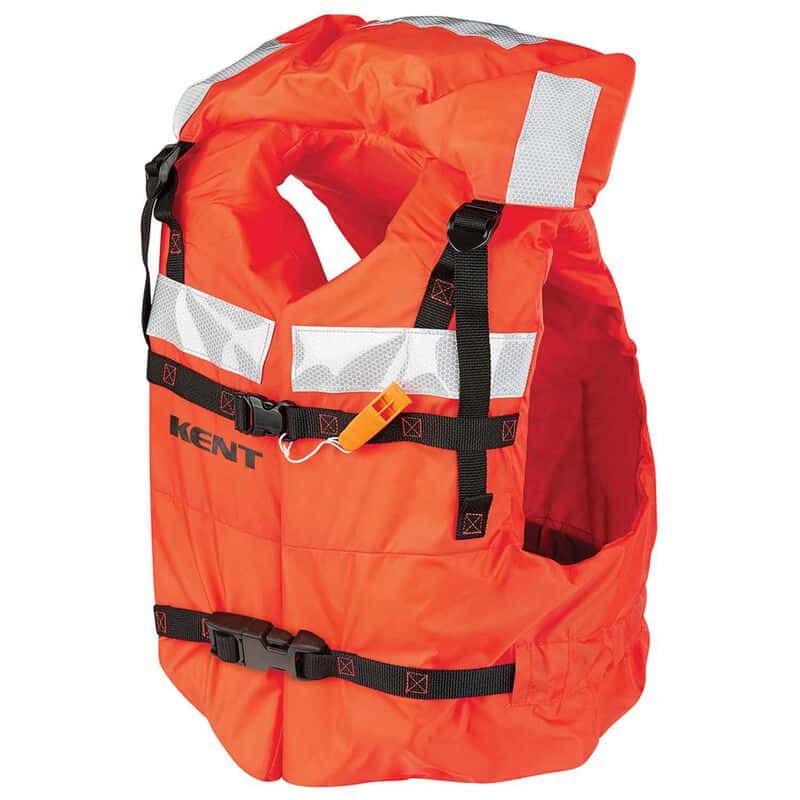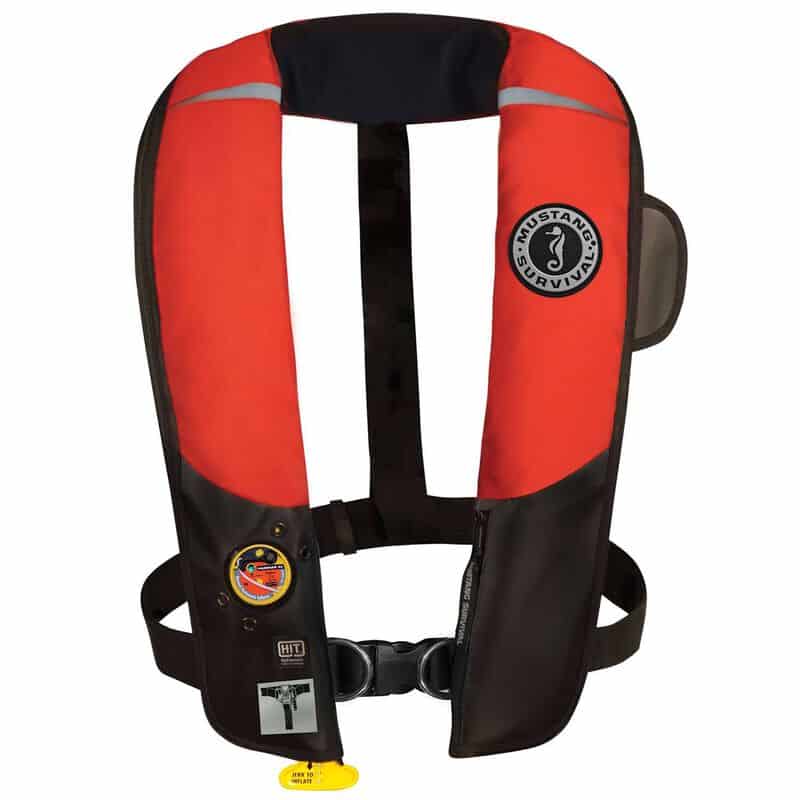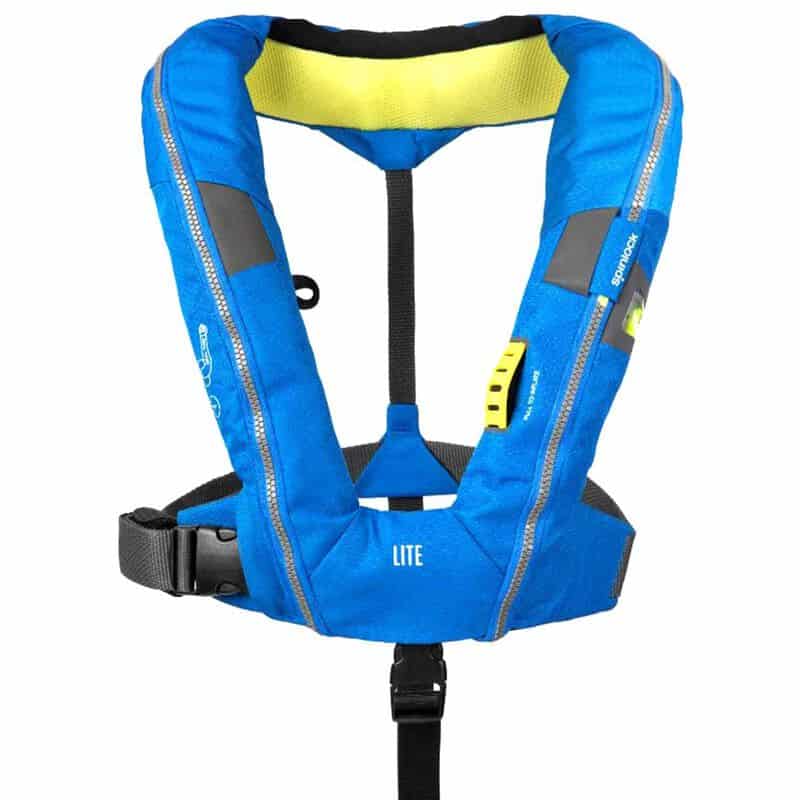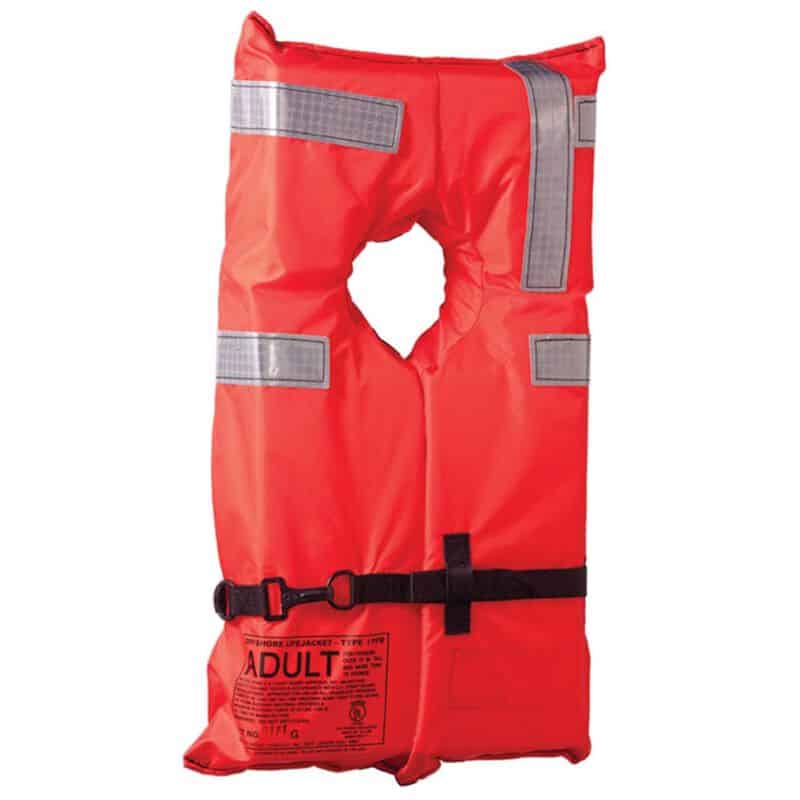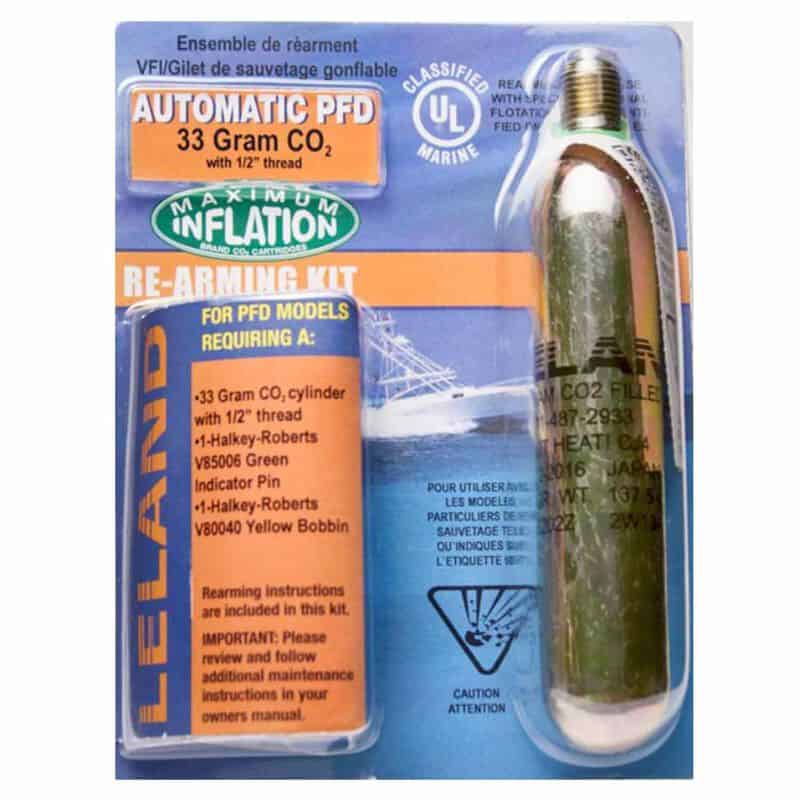10 Most Reliable Sailing Life Jackets (Adults and Kids).

Safe and reliable life jackets were always a priority, while we lived on two sailboats with our three kids. This post will help you decide which PFD is right for you.
We have tried quite a few PFD’s, until we ended up with a combination of what I am listing below.
What the heck is a PFD? It stands for Personal Floatation Device. Read on, I have it all answered here.
Some of our life jackets and vests were a compromise between price and comfort.
Never compromising safety. This is your boat-mama guide.
Check out our Boat Gear Page, for all the things we need and want aboard – essentials, safety, galley, everyday life.
Our top 3 choices. USCG approved.
Short on time? Here are my top three recommendations – US Coast Guard approved.
Most reliable
KENT Commercial Type I Life Jacket
We had 4 aboard. Extremely safe and reliable. USCG approved.
Best Inflatable
Mustang Survival Corp Inflatable PFD
Great for long passages. HIT auto inflate. USCG approved.
Safest for Kids
Stohlquist Kids Life Jacket USCG Approved
Specially designed for kids 30-50lb. Bright, comfortable, reliable.
Here are my recommendations:
We have zipped and clicked through lots of PFD’s. We started with younger kids, who grew as we lived aboard. As our cruising life changed, so did the cruising life jackets.
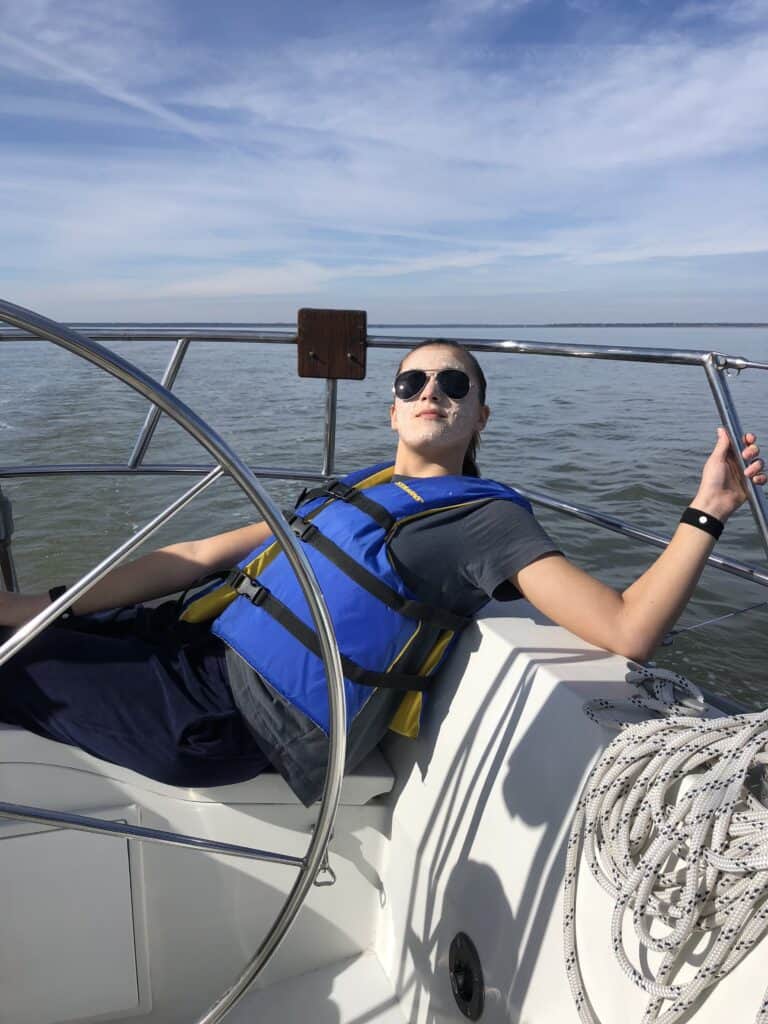
As we have always sailed USCG registered boats, my recommendations and tips are in accordance with these regulations.
1. Most reliable for offshore cruising
KENT Commercial Type I Life Jacket
We had four of these jackets aboard. They were bulky, large and everyone hated wearing them.
This Type I lifejacket, can actually save someone’s life, while cruising offshore, and especially in rough conditions.
When we were sailing in the middle of the night, away from anything and everything, the last thing I needed was a fatality in a comfortable life jacket. Go ahead and argue.
While on the topic of safety, these two posts are very useful:
12 Safety Gear Essentials for the High Seas.
First Aid Kit Aboard – Supplies and Organization
Actually, the bulk provides nice insulation during a cold breezy night, and the head support is so bulky, that it acts as an in-built pillow. I doze off in mine quite a few times, while on shift.
Now, we did not wear these all the time, they were always within reach during passages and only those on shift wore them, only while outside.
Pros
- Type I – offshore USCG approved.
- All swim levels, including none.
- Suitable for rough weather.
- Designed to turn an unconscious person.
- Can help prevent hypothermia.
Cons
- Bulky
- Takes up space
2. Best inflatable – US
Mustang Survival Corp Inflatable PFD with HIT (Auto Hydrostatic)
So, everyone loves inflatables. You see them at boat shows, in boating magazines, on fancy yachts.
Inflatables are very comfortable, reliable, and no one will complain aboard.
This Mustang Inflatable with HIT has 35lb of buoyancy, and the HIT technology makes it so that it auto inflates only under around 4 inches of water pressure. So, you do need to be submerged; it won’t open in heavy rain, nor if a wave splashes over you.
It has the D rings, which are great, because it is a hassle to have to put on a separate harness, and then a life jacket on top. You need a harness (or the D rings), to tether to the jacklines, while walking on deck, during passages, especially if rough, dark, or alone on shift.
Inflatables are a bit controversial when it comes to the US Coast Guard. They are only approved for adults, meaning no child under 16 years old may wear them and be considered compliant, by the USCG.
I do understand the logic behind this, but our 13 year-old is a competitive swimmer, 6′ tall and weighs 160lb. He should be OK in an inflatable offshore. Parents should be able to figure out what’s best for their children (then, again, we homeschool).
We only had one inflatable aboard, and it was worn by the adult on shift, at night. It worked well for us.
Pros
- Auto-inflated only under water.
- Will not inflate in rain or splashing.
- USCG Type II performance.
- D-rings for a tether to jacklines.
- Comfortable and lightweight.
- Will fit a larger built.
- Maintain-free 5 years / till inflated.
Cons
- Not approved under 16 years old
- Requires maintenance
- Expensive
- Only available in the US
3. Best inflatable – worldwide
Spinlock Deckvest LITE USCG 170N Lifejacket
Go into any cruising forum out there and you are bound to see a Spinlock. They are very well-made. They have passed tests by water rescue pros, with flying colors.
If you want a well-designed, super comfortable, inflatable, get a Spinlock. Unlike the Mustang, these can be purchased throughout the world, and they come in children’s sizes.
But an inflatable is not approved for anyone under 16 years of age, by the US Coast Guard. But the US coast is only a small part of the world.
Honestly, I hope that changes. The US is a bit behind in allowing cruisers to choose freely.
As with all inflatable sailing life jackets, maintenance is required. It must be “loaded” with a full CO2 cylinder (after it has already been inflated, it does come ready to use). Everything on the jacket must be marked as working (showing green).
Even though this is a great model, I might shop for some of their other models, I think they have better ones. This one is just one of the few USCG approved.
Unfortunately, it does not come with a harness, so you’d have to put on a harness to tether.
From a bunch of reviews I read, people with larger bodies find it a bit restrictive.
Pros
- For weak and strong swimmers.
- Very reliable.
- Comfortable and lightweight.
- USCG approved (this model).
- 38lb buoyancy (170N).
Cons
- Not approved under 16 years old
- Expensive
- Requires maintenance.
- No harness (but this one has it)
- A bit small for larger bodies.
4. Best universal – coastal cruising and watersports
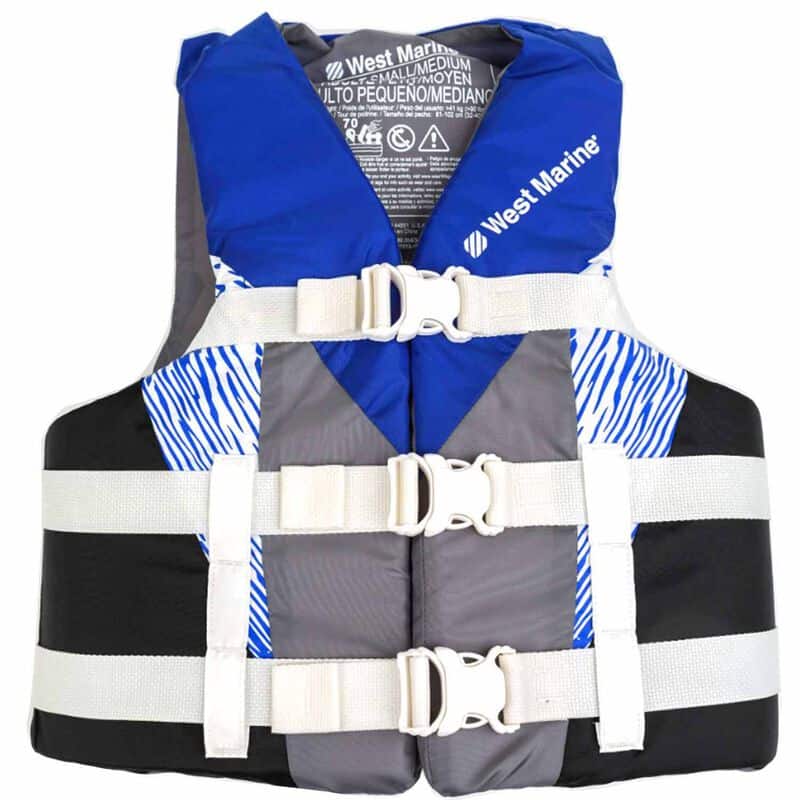
We had three lightweight USCG Type III life vests aboard. They are great for dinghy rides, wakeboarding, jet-skiing, or any other water sport.
They are buoyant and will keep you above the water, which is why I would not recommend them for snorkeling. We have seen people snorkel in similar life vests, but that is because it is mandatory on commercial touring boats and day-charters.
We would hang ours on the lifelines, especially during rainstorms, so they were rinsed with fresh water. They dry very quickly.
Everything involved in boating life must be comfortable and quick drying. You will enjoy my posts about sailing outfits and shoes:
9 Sailing Outfits for any Season and Reason
Comfortable Sailing Shoes for All Your Boating Needs
Recreational life jackets requires no maintenance, except keeping them away from the sun and moisture, when not in use.
Best of all – comfortable and not very expensive.
Pros
- Lightweight
- Low maintenance
- USCG Approved Type III
- Versatile, good for water sports
Cons
- Not as comfortable for paddling
5. Most comfortable for paddling and kayaking
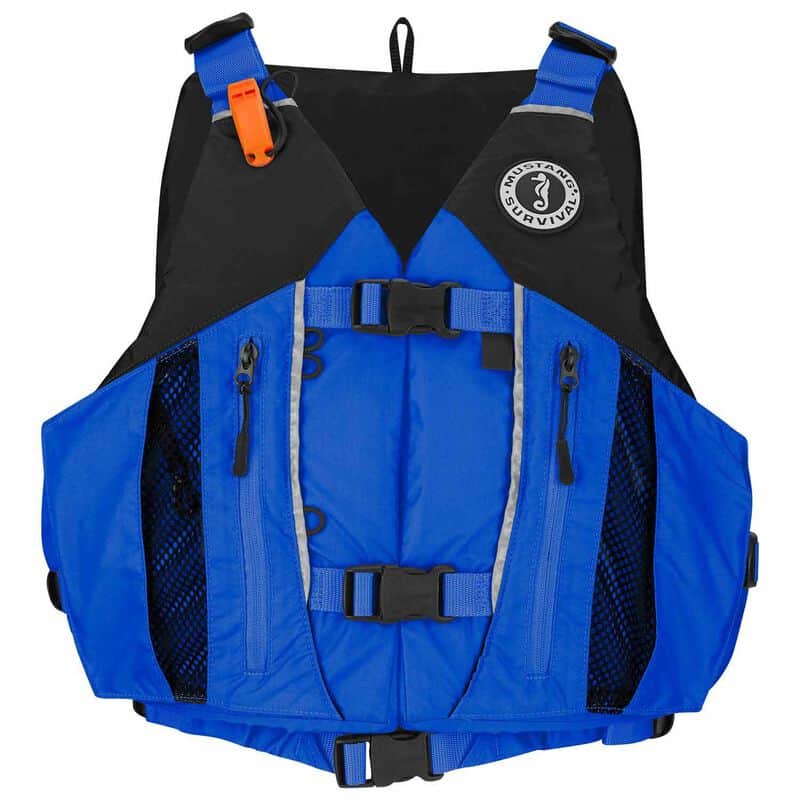
If you love exploring meandering rivers and mangrove forests, you will find yourself spending hours in your kayak. Or the paddleboard.
Paddling life jackets are designed with paddling in mind. As well as any other water sport, requiring swift and wide arm movements.
These types of PFD’s are favorites for sailing races as well. They are breathable and comfortable, while sitting high up to allow for freedom of movement in all directions.
However, such life jackets are not USCG approved for offshore use, making US competitors find creative ways to use them by wearing them, while keeping the USCG uncomfortable ones aboard as “available, if needed”.
This PFD is made for adults weighing over 90lb. It will easily fit many teens as well.
Pros
- Excellent freedom of movement
- Great for all paddling water sports
- Great ventilation
- USCG approved Type III
Cons
- Not approved for offshore cruising
- For adults over 90lb
6. Universal for youth (50-90lb)
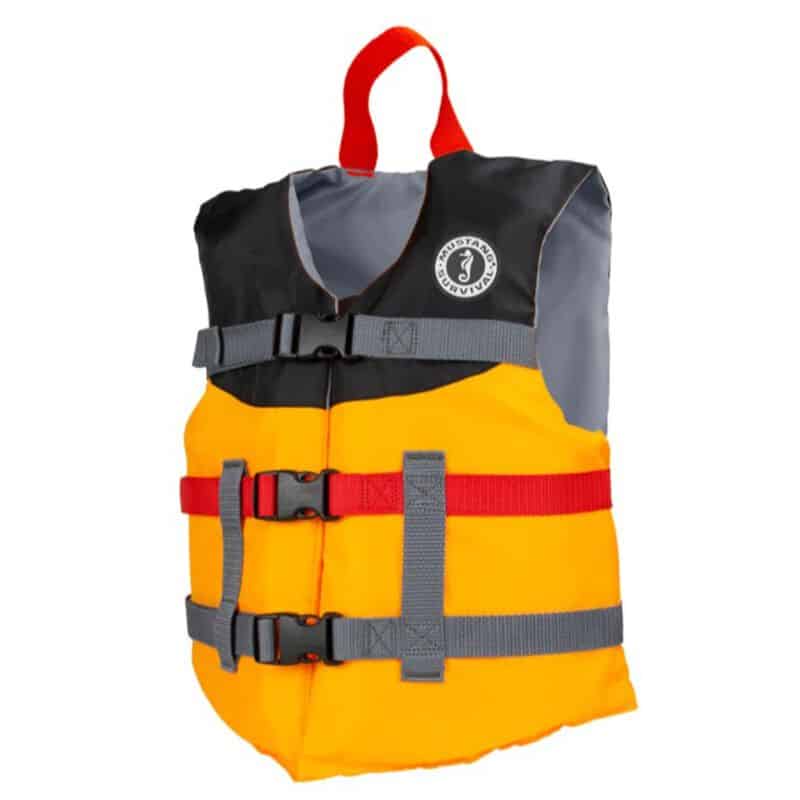
For children weighing between 50 and 90 lb., this will make a great life jacket, for water activities, and to wear in the dinghy, or on the marina docks, if not a good swimmer.
When we moved aboard, our youngest was 8 years old, and even though he was a swimmer, he was always in a life jacket when out on deck, while the boat was moving.
Note – it is a USCG requirement that all children age 13 and younger must be wearing a life jacket, when on deck and underway. They don’t need them below deck, or in an enclosed cockpit.
With kids, the hardest part is getting them to wear the darn thing! Any mom will know what I mean.
We had a similar life jacket, which our two boys outgrew very quickly (because they just grew very fast, nothing wrong with the sizing of the jacket). They did not like wearing life jackets (sound familiar?).
Especially, if their friends did not wear them…
Other boating moms, make your older kids be a good example for the younger boat-kids around. All it takes is a second and someone might be in the water, when no one is looking.
Pros
- USCG approved 50-90lb
- Bright, visible yellow
- Easy-grab handle
- Lightweight and soft
Cons
- Not for non-swimmers.
7. Universal for children (30-50lb)
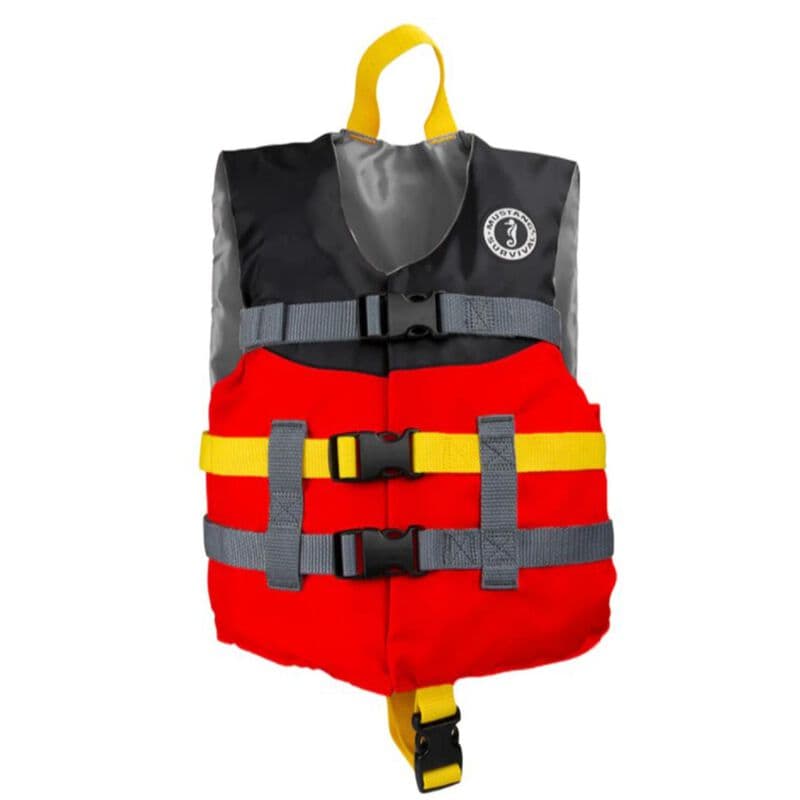
They just outgrow them so fast!
I could not wait for our kids to move into the teenage zone, so we would stop changing life jackets.
What I like about this jacket is the crotch strap, the handle and the bright red and yellow for visibility.
According to USCG regulations, no children’s (30-50lb) and few youth’s (50-90lb) life jackets are rated as Type I, suitable for offshore cruising. Some vests have it on the tag, but that is due to the higher buoyancy. Like this one.
Speaking as a parent, no young kids have any business out on deck, during passages, in rough conditions.
On calm sunny days, when there is barely a breeze and the boat is going at 1.5 knots, and all you want to do is swim over the continental slope, so you have bragging rights in front of all your friends – we have done it.
Watch our episode about all kind of fun activities, while slow sailing the Great Bahama Bank.
Pros
- USCG approved 30-50lb
- Bright, visible red
- Easy-grab handle
- Crotch strap
Cons
- Older kids might not like the crotch strap.
8. Most reliable for the youngest (up to 30lb)
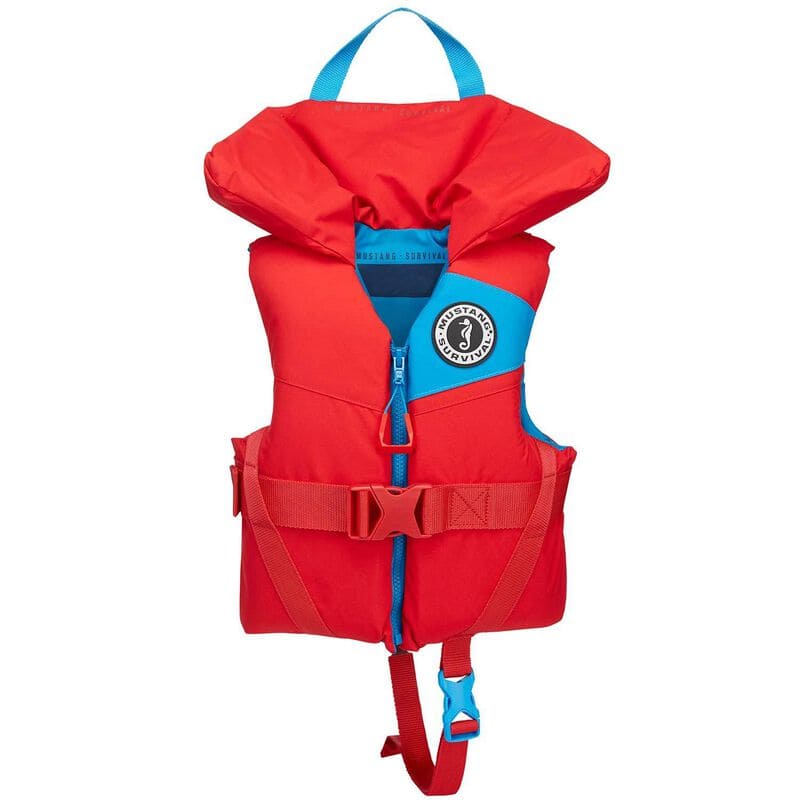
This PFD is especially designed for youngest ones in mind. It does check pretty much all mom boxes, as far as boating moms are concerned.
As with all younger kids – getting the child to wear the jacket, any jacket, is a parental victory worth celebrating.
While the collar makes perfect sense, as it can help keep the head water, it can be a bit uncomfortable to just wear all the time.
That handle though – I have tried it, and it works like a charm!
We had a tiny boat-friend over, and when it was time to leave, at night, she had to get into the dinghy, in a bit of a rocky anchorage. The handle helped me pick her up and position her right inside the dinghy, by her parents.
Those on/off dinghy transfers can be very tricky; we have all fallen overboard!
Pros
- USCG Type III (Type II in Canada)
- For kids up to 30lb
- Very bright colors – easy to spot
- A handle for quick grab!
- A crotch strap
Cons
- Not approved for offshore cruising
- Might feel bulky with the collar.
9. Perfect for guests aboard
Adult Over 90lb Type I Life Vest
If you have guests visiting the boat, there must be a life jacket for every person aboard. It is the law, and it makes sense.
Go tell Grandma that she needs to pack a bulky life jacket in her carry-on bag, instead of some goodies for you… No, don’t!
Just buy some of these to have aboard, for anyone visiting.
We had four, plus a kid’s one, since we have a young cousin too. If you decide to buy the package of four, they are all bagged and ready to store away some place.
Store four – where!!!
Use the packaged four as an extra seat, or even a coffee table, out in the cockpit, just put a flat tray on top.
Seriously, the possibilities are many – just think outside the box, when buying the box.
Pros
- Excellent for guests aboard
- USCG approved Type I
- Easy to use
- May turn an unconscious person.
Cons
- Not very comfortable.
Click HERE to view a package of four.
10. Best compact PFD
Onyx M-16 Series Belt Pack Manual Inflatable Life Jacket
Speaking of guests aboard – these will be perfect for good swimmers.
They are small, convenient, will not be in the way at all, and they will not inflate automatically.
This means you can jump aboard for a short ride, or go paddle-boarding, without anything restricting your movement, and fall in the water as much as you want.
The belt pack inflatable is designed with plenty of buoyancy (up to 26lb when additionally inflated, on top of the CO2 cartridge), so it will float an adult on his/her back.
However, I would not give it to a weak swimmer.
The person in the water must remain calm enough and possibly thread water for a bit, while inflating and pulling the belt over his/her head.
This PFD is so compact, cute and universal, that it will also make a great gift for any boater. Speaking of gifts – Check out my post with tons of other cool and useful gift ideas:
51 Classic Gifts for Boaters (Cruisers Approved)
Pros
- USCG approved Type V
- Very compact and convenient
- Extra air can be added manually
- Easy to pack in a carry-on bag.
- Perfect for guests.
Cons
- Must inflate manually
- Must pull belt over head if inflated
And now, as promised, the understandable answers to, “What the heck is a PFD?”
What is a PFD?
PFD stands for Personal Floatation Device.
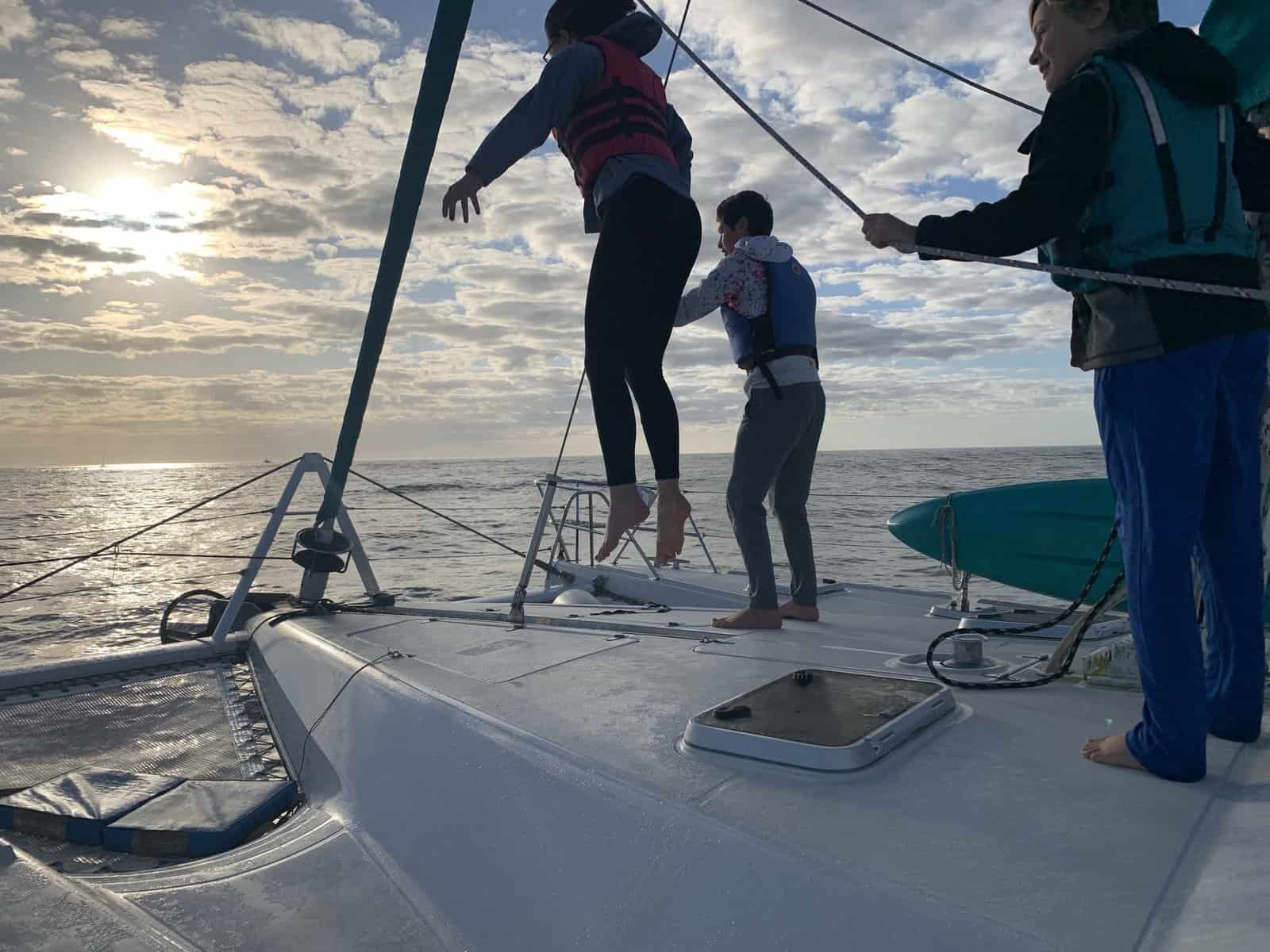
This includes life jackets, vests, as well as essentials such as throwable cushions and ring buoys.
I have a helpful post all about boating essentials: 15 Safety Gear Essentials for the High Seas.
Types of PFD’s according to the US Coast Guard
Type I
- Wearable PFD – jackets and vests
- Greatest buoyancy (quite bulky)
- Will turn most unconscious people from a face-down position.
- For all swim levels, including non-swimmers.
- Suitable for offshore cruising and rough seas.
- Available only for adults (over 88lb).
Type II
- Wearable PFD – jackets and vests
- May turn an unconscious person.
- Most are suitable for sailing, boating and water sports.
- Better for people somewhat comfortable in the water.
- Available for adults (over 88lb)
- Available for youth (between 55lb and 88lb)
- Available for children (between 33lb and 55lb)
- Available for infants (less than 33lb)
Type III
- Wearable PFD jackets and vests
- Suitable for conscious people, and those who can swim.
- Comfortable to wear, due to less bulk.
- Not for offshore cruising.
- Suitable for water sports.
- Available for adults, youth and children.
Type IV
- Throwable PFD’s – cushions, ring buoys.
- Must be within reach at all times, while vessel in motion.
- Suitable to throw to a person, who can swim and grab onto it.
Type V
- Special restrictions and uses for particular sports and activities.
* The US Coast Guard has an additional classification, more in line with international standards – buoyancy. Classification according to type is more common and easier, which is why I am only focusing on that.
Useful PFD Accessories
These are useful to have, especially, if sailing away, where access to extras is either limited, or costly.
For more safety items you should have aboard:
12 Safety Gear Essentials for the High Seas.
Rearming kits
Rearming kit for inflatable life jackets
The inflatable life jackets all come with a ready and loaded CO2 cartridge, and, depending on the model, some other accessories as well.
Once inflated, however, the CO2 must be replaced, prior to using again. Hence the maintenance required.
The generic rearming kits work just fine and are less expensive. But some companies only allow use of their brand rearming kits, or the product warranty will be voided (Mustang is one of them).
If you choose to buy generic replacements (maybe to keep “just in case”), make sure they are the right kind for your inflatable. Both inflatables I am recommending use the 33g 1/2″ threaded kind.
Buy a spare kit, put it away and sail away.
Click HERE to view and purchase for Mustang Inflatable
Click HERE to view and purchase for Spinlock DeckVest
Click HERE to view and purchase generic
Storage box
Fasrom T-top Storage Bag for Boat Life Jackets can be attached under the bimini, in the cockpit so it will be in the shade and off the deck floor.
It is easy to grab the life vests, as needed, and you avoid cluttering the cockpit and cabin with life jackets.
I have an entire post dedicated to various boating bags, check it out:
19 Best Boating Bags. Tips How to Use Them.
Rules to stay safe while cruising.
Here are essential rules, related to using life jackets and other PFD’s while on the water.
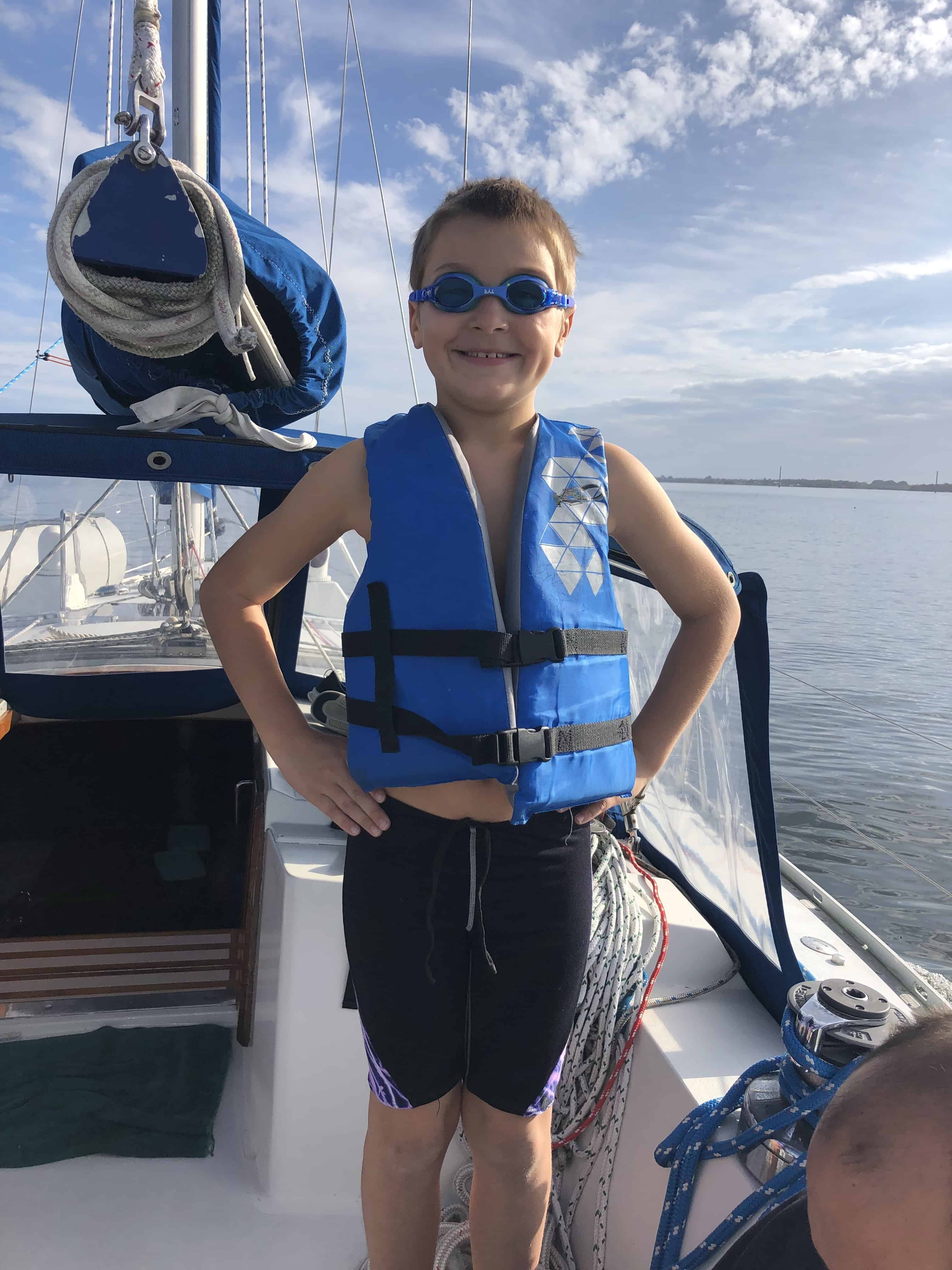
Some of these are official, some are ours (so, even more official), others are what friends of ours follow. Pick and choose according to your needs, kids’ ages and swim ability.
My major (sometimes the only) mama rule is to always know where the crew are, while underway.
USCG Rules
- “The best lifejacket is the one you will wear.” US Coast Guard
- According to USCG there must be a life vest for every person aboard a vessel.
- While underway, a PFD must be readily accessible, at all times.
- Child 13 and under, must wear a PFD, while the on deck and underway.
- If sailing in the US, check for additional, state requirements.
Common and Commonsense Rules
- All indicators must be in the green to use, for inflatable PFD’s.
- During passages, life jackets and PFD’s must be within easy reach.
- Practice throwing a throwable and a ring buoy.
- Only adequate swimmers should wear inflatable life jackets.
- Do man-overboard drills.
Boat-mama Rules
These rules are somewhat different, depending on the ages of the kids, the duration of the passage and the state of the sea.
- At night, on anchor – always buddy system when out of the cockpit.
- Underway – always buddy system when out of the cockpit.
- Everyone in the crew must know how to swim.
If you have seen our YouTube videos, you will see us jumping and swimming off the boat, while underway, offshore.
Living in a life jacket is impractical, so being aware of where everyone is aboard, has been my top priority in all our sailing adventures.
Frequently Asked Questions
What is the best color for a life jacket?
Anything that is not the color of the ocean, or the sky. Bright red, orange, yellow, green, multi-color. Having reflective bands is always a god idea.
Should I wear a life jacket sailing?
Yes, you should, while on deck. In rough conditions, you might want it on, inside, just in case, until the storm passes.
Note: Any major storm can be avoided with the modern-day navigational instruments. Occasional storms off-shore are not always easy to avoid.
How Much Do Top Sailing Life Jackets Cost?
Between $60 and $400, depending on the intended use and brand. Inherently buoyant and foam jackets and vests are cheaper. Inflatables are more expensive.
We decided to only have one inflatable life jacket for the adult on shift, during a passage – everyone else had foam ones.
What is the safest use of a life jacket?
Putting it on.
Find one here, buy it and wear it: 10 Most Reliable Sailing Life Jackets (Adults and Kids)
Can I take my inflatable life jacket on a plane?
According to the TSA, “You may bring a life vest with up to two CO2 cartridges inside, plus two spare cartridges in your carry-on or checked bag… You may not transport CO2 cartridges without the associated lifejacket.”
What is the difference between a PFD and life jacket?
A life jacket is a type of PFD. PFD stands for Personal Floatation Device and includes life jackets, life vests, inflatables, throwable cushions, ring buoys and so on.
Which PFD has the most buoyancy?
The inherently buoyant, and some inflatables provide the greatest buoyancy, with some Type I providing up to 35lb.
How many pounds of buoyancy do I need?
According to the USCG most adults require between 7-12lb of buoyance to keep their head above water. For youth, between 11 and 15lb, and around 7lb for smaller children and infants.
To summarize
Check out our Boat Gear Page, for all the things we need and want aboard – essentials, safety, galley, everyday life.
There are lots of options for sailing life jackets out there. It is easy to feel overwhelmed and overthink it.
I wrote this post as a guide, and even if you have different favorite brands, use it as a resource, to help you narrow down your options.
Those looking for a great gift for boaters – life jackets and PFD’s are always needed aboard, just discuss with the crew first.
Other posts related to boat essentials.
12 Safety Gear Essentials for the High Seas.

